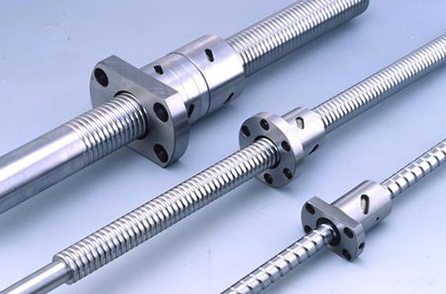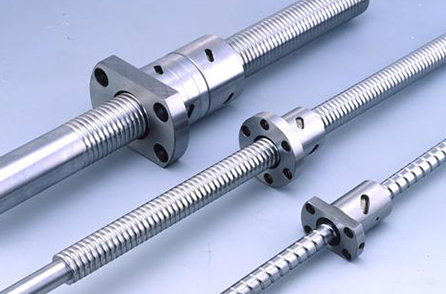丝杠制作过程解析
来源:http://www.jngongrun.com/ 日期:2025-07-16 发布人:
丝杠的制作需经多道精密工序,从原材料到终检验,每步都影响其精度与寿命,需结合使用场景严格把控。
The production of lead screws requires multiple precision processes, from raw materials to final inspection, each step affecting its accuracy and lifespan, and must be strictly controlled in conjunction with the usage scenario.
原材料选择与预处理是基础。常用 45 号钢、40Cr 合金结构钢,高精度丝杠用 GCr15 轴承钢(含碳 0.42%-0.50%),经热处理后硬度达 HRC58-62。原材料为圆钢棒,直径比成品大 5-10mm,表面无缺陷,磁粉探伤检测内部杂质。预处理需退火:820-860℃加热 2-3 小时后缓冷,硬度降≤229HB,改善切削性能防崩刀。
The selection and pretreatment of raw materials are the foundation. 45 # steel and 40Cr alloy structural steel are commonly used, and GCr15 bearing steel (containing 0.42% -0.50% carbon) is used for high-precision lead screws. After heat treatment, the hardness reaches HRC58-62. The raw material is round steel rod, with a diameter 5-10mm larger than the finished product, and there are no surface defects. Magnetic particle inspection is used to detect internal impurities. Pre treatment requires annealing: Heat at 820-860 ℃ for 2-3 hours and then cool slowly to reduce hardness to ≤ 229HB, improving cutting performance and preventing tool breakage.
粗加工塑造基本形态。下料用锯床切割,长度比成品长 10-20mm,切口垂直度偏差≤0.5mm/m 防偏心。车削外圆时,车出轴颈、退刀槽,留 2-3mm 精加工余量,表面粗糙度 Ra3.2μm 以下。长丝杠(>1m)用跟刀架辅助,控制径向圆跳动≤0.1mm。粗加工后时效处理:120-150℃保温 4-6 小时,应力防变形。
Rough machining shapes the basic form. Cut the material with a sawing machine, with a length 10-20mm longer than the finished product, and the vertical deviation of the cut should be ≤ 0.5mm/m to prevent eccentricity. When turning the outer circle, the journal and tool groove should be machined out, leaving a 2-3mm precision machining allowance and a surface roughness of Ra3.2 μ m or less. Long filament bars (>1m) are assisted by a trailing tool holder to control radial circular runout ≤ 0.1mm. After rough machining, aging treatment is carried out at 120-150 ℃ for 4-6 hours to eliminate stress and prevent deformation.
螺纹加工是核心工序。普通精度丝杠(C 级)用螺纹车床车削,高速钢螺纹刀进给 0.1-0.3mm/r,多次走刀(每次切深 0.1-0.2mm),保证牙型清晰。高精度丝杠(C3 级)用螺纹磨床磨削,白刚玉砂轮(60-80 目)配合乳化液冷却,中径公差 0.01-0.03mm,导程误差≤0.02mm/300mm。滚珠丝杠需加工循环槽,与滚珠间隙 0.01-0.02mm,专用刀具加工使槽面 Ra0.8μm 以下。
Thread machining is the core process. Ordinary precision screw (Class C) is turned with a thread lathe, and the feed rate of the high-speed steel thread cutter is 0.1-0.3mm/r, with multiple passes (each cutting depth is 0.1-0.2mm) to ensure clear tooth profile. High precision screw (C3 grade) is ground using a thread grinder, with white corundum grinding wheel (60-80 mesh) and emulsion cooling. The diameter tolerance is 0.01-0.03mm, and the lead error is ≤ 0.02mm/300mm. The ball screw needs to be processed with a circulating groove, with a clearance of 0.01-0.02mm between the ball and the groove surface. Special cutting tools should be used to process the groove surface with a Ra0.8 μ m or less.

热处理强化性能。螺纹加工后淬火:830-860℃加热 1-2 小时油冷,表层 HRC55-60,心部 HRC30-40。随即低温回火:150-200℃保温 2-4 小时,应力稳组织。高耐磨性丝杠(如注塑机用)进行氮化处理:500-560℃通氨气,形成 0.1-0.3mm 氮化层,硬度 HV800-1000。热处理后检查变形,弯曲超差(直线度>0.1mm/m)用压力机校直。
Heat treatment enhances performance. Quenching after thread processing: Heat at 830-860 ℃ for 1-2 hours and oil cool, with a surface HRC55-60 and a core HRC30-40. Immediately low-temperature tempering: maintain at 150-200 ℃ for 2-4 hours to eliminate stress and stabilize the structure. Nitriding treatment of high wear resistant lead screws (such as those used in injection molding machines): passing ammonia gas at 500-560 ℃ to form a 0.1-0.3mm nitride layer with a hardness of HV800-1000. After heat treatment, check for deformation and straighten with a press if the bending exceeds the tolerance (straightness>0.1mm/m).
精加工与检验保障质量。精密磨削外圆 IT6-IT7 级公差,修正螺纹误差,保证螺纹与外圆同轴度≤0.02mm。轴颈磨削配合要求(过盈量 0.005-0.01mm),轴肩端面跳动≤0.01mm。检验用螺纹千分尺、导程仪等,测中径、导程误差及粗糙度(Ra≤1.6μm),重要丝杠需动态测试。合格丝杠清洗后涂防锈油,套塑料保护套防磕碰。
Precision machining and inspection ensure quality. Precision grinding of the outer circle to IT6-IT7 tolerance, correction of thread errors, ensuring that the coaxiality between the thread and the outer circle is ≤ 0.02mm. Grinding of the shaft neck to fit requirements (interference fit 0.005-0.0mm), and shaft shoulder end face runout ≤ 0.01mm. Inspection uses thread micrometers, lead gauges, etc. to measure the pitch diameter, lead error, and roughness (Ra ≤ 1.6 μ m), and important lead screws require dynamic testing. After cleaning the qualified screw, apply anti rust oil and cover it with a plastic protective sleeve to prevent collision.
不同丝杠制作有差异:梯形丝杠重牙型对称,滚珠丝杠重滚珠槽精度,微型丝杠(<10mm)用高精度夹具(定位误差≤0.005mm)防振。制作需在 20±2℃恒温车间进行,减少温度对精度的影响,确保满足机械传动需求。
There are differences in the production of different lead screws: trapezoidal lead screws have symmetrical heavy tooth profiles, ball screws have precision in heavy ball grooves, and micro lead screws (<10mm) use high-precision fixtures (positioning error ≤ 0.005mm) to prevent vibration. The production needs to be carried out in a constant temperature workshop at 20 ± 2 ℃ to reduce the impact of temperature on accuracy and ensure that mechanical transmission requirements are met.
本文由导轨丝杠友情奉献.更多有关的知识请点击:http://www.jngongrun.com真诚的态度.为您提供为的服务.更多有关的知识我们将会陆续向大家奉献.敬请期待.
This article is a friendly contribution from the guide screw For more information, please click: http://www.jngongrun.com Sincere attitude To provide you with comprehensive services We will gradually contribute more relevant knowledge to everyone Coming soon.
- 上一篇: 丝杠动态刚度怎么检测呢?
- 下一篇:导轨抗腐蚀材料有哪些?
 导轨丝杠:从设计结构...<>
导轨丝杠:从设计结构...<> 大型丝杠的性能设计介...<>
大型丝杠的性能设计介...<> 梯形丝杠和滚珠丝杠的...<>
梯形丝杠和滚珠丝杠的...<> 滚珠丝杆目前的行业的...<>
滚珠丝杆目前的行业的...<> 滚珠丝杠螺母油封更换...<>
滚珠丝杠螺母油封更换...<>



